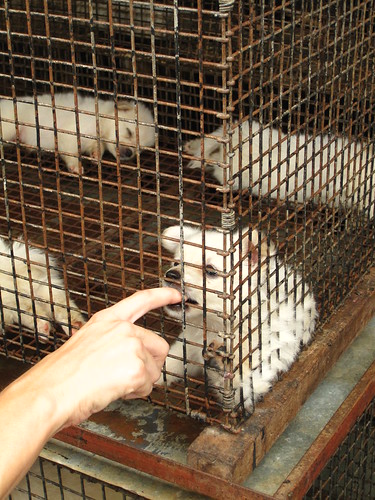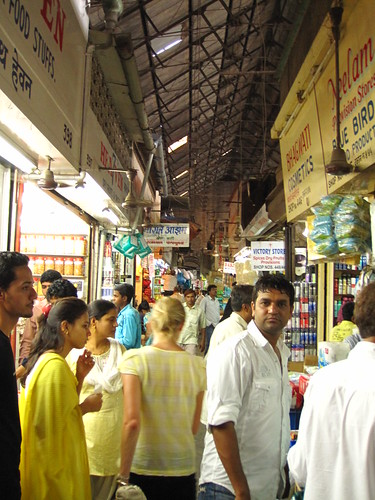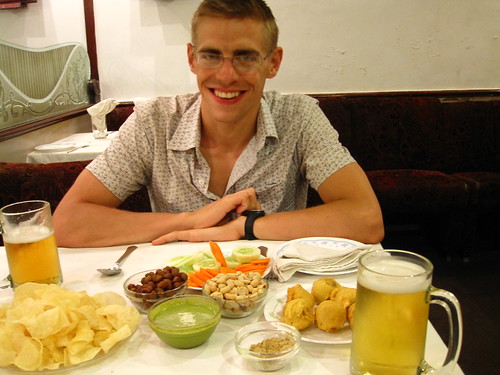Once our overnight train from Aurangabad brought us back into Mumbai, we settled in and started strolling the bazaars. There are three major bazaars strung together in the middle of the city, the first of which is the Chor Bazaar, which is best known for its antiques. We enjoyed poking among the dusty curios, but caught on to the fact that the second best feature of the bazaar is metal working goods, which proved far more interesting. Every kind of tool, screw, and piece necessary to build a car or house can be found in those streets, making a 10-block hardware store out of the stroll, which Ben really loved.
 The next bazaar, beginning a few blocks south, is the Zaveri, home exclusively to jewelry, much more fun for me! The Indians tend toward shiny gold and huge, ornate, bib-like necklaces, so I didn’t find anything to bring home, but I loved looking around. The final bazaar is the huge, covered Crawford Market, which began years ago in a beautiful European building with workers’ scenes covering the doorways, and now sprawls through several blocks in every direction. The stalls contain all kinds of household goods from vegetables to fly-covered hunks of meat to cleaning fluid to pets (puppies!). We spent a lot of time looking everything over, especially the puppies, before heading out to dinner.
The next bazaar, beginning a few blocks south, is the Zaveri, home exclusively to jewelry, much more fun for me! The Indians tend toward shiny gold and huge, ornate, bib-like necklaces, so I didn’t find anything to bring home, but I loved looking around. The final bazaar is the huge, covered Crawford Market, which began years ago in a beautiful European building with workers’ scenes covering the doorways, and now sprawls through several blocks in every direction. The stalls contain all kinds of household goods from vegetables to fly-covered hunks of meat to cleaning fluid to pets (puppies!). We spent a lot of time looking everything over, especially the puppies, before heading out to dinner.


 Most casual restaurants in India don’t serve alcohol, so after dinner we decided to stop by a slightly nicer place to have a couple drinks. It cracked us up as the waiters brought about six different food courses to be enjoyed with our beers, all free - the Indian hospitality at its finest. We could have skipped dinner altogether and had the freebies instead, but it just showed us another cultural quirk unique to India, or perhaps Mumbai.
Most casual restaurants in India don’t serve alcohol, so after dinner we decided to stop by a slightly nicer place to have a couple drinks. It cracked us up as the waiters brought about six different food courses to be enjoyed with our beers, all free - the Indian hospitality at its finest. We could have skipped dinner altogether and had the freebies instead, but it just showed us another cultural quirk unique to India, or perhaps Mumbai. The next morning, after we hopped into a cab, I commented that I was surprised that we hadn’t yet been involved in an accident, since traffic in India is so fast, crowded, and chaotic. Of course, about 2 minutes later, we were rear-ended by another taxi and I was cursing myself for saying anything about it. It turned out to be a minor fender-bender, and a reminder to keep such thoughts to myself!
The next morning, after we hopped into a cab, I commented that I was surprised that we hadn’t yet been involved in an accident, since traffic in India is so fast, crowded, and chaotic. Of course, about 2 minutes later, we were rear-ended by another taxi and I was cursing myself for saying anything about it. It turned out to be a minor fender-bender, and a reminder to keep such thoughts to myself!Our cab was taking us to a tour of the Dharavi slum, something we had been reluctant to undertake for fear of exploiting the residents and treating them like zoo animals. However, under the reassurance of some other travelers, we decided to join a nonprofit tour group and give it a shot. The organization that arranges the tours runs a slum school with the proceeds, and forbids photography (these photos are from their website), which made us feel a bit more optimistic about the whole experience, and it turned out the be the right decision. We were absolutely amazed at the amount of industry contained in the slum, and the optimistic pride in the residents. Dharavi is home to one million people, and its industries earn over $665 million per year. In Mumbai, 55% of the residents live in slums, taking up only about 7% of the land, so the kind of life we saw is a simple fact for so many people. The homes were very simple, tiny concrete huts, and the lanes were dirty and only about the width of Ben’s shoulders - we would never have found our way through without the guides. People live and work within the small spaces, recycling plastic and aluminum bottles and cans, making mud pottery for transporting water, sewing T-shirts and working with leather. The next time I see “Made in India” on one of my shirts, I will think of Dharavi slum! It’s easy to feel sorry for people living in such a cramped, ramshackle place, but the impressions I got were the opposite - the residents we met were happy, and proud to be neither homeless nor unemployed. There are many definitions of poverty, and these people didn’t seem interested in applying one to themselves. They were too busy working hard and getting on with their lives. Of course, for all the inspiring spirit, we saw a man walking through a horrible, sewage-filled river collecting bottles to recycle, and I was reminded that this still isn’t a dream job for most people. Altogether, the tour was an absolutely fascinating window into Mumbai life.


 To cap off our time in India, we ended up at a beautiful, fancy dinner to get a taste of high-end Indian food. It was absolutely amazing! We had followed a vegetarian diet for the preceding three weeks, on the advice of our guidebook and other travelers who blame meat from cheap (dirty) restaurants as the most common reason people get sick in India - avoiding it could be why we stayed healthy, but we can’t be sure. Anyway, at Khyber, we indulged in delicious meat and fish, and had about 5 servers just for our table. It was such a treat, and a glimpse into how the Indians not from Dharavi slum live.
To cap off our time in India, we ended up at a beautiful, fancy dinner to get a taste of high-end Indian food. It was absolutely amazing! We had followed a vegetarian diet for the preceding three weeks, on the advice of our guidebook and other travelers who blame meat from cheap (dirty) restaurants as the most common reason people get sick in India - avoiding it could be why we stayed healthy, but we can’t be sure. Anyway, at Khyber, we indulged in delicious meat and fish, and had about 5 servers just for our table. It was such a treat, and a glimpse into how the Indians not from Dharavi slum live.Our experience in India was so fascinating and interesting, and something I will never forget. We have since moved on to Hong Kong and Bangkok (sorry we are falling behind with the blogging!) and are still having an amazing time, but India has stayed in my thoughts, as I’m sure it will continue to.
I am so glad you got to see that side of India. It sounds like something everyone should get to see, especially when we get down, or think we don't have enough. We don't know what true poverty is.
ReplyDeleteHave fun in Thailand!
A great final spell in Mumbai. I had an Indian mother in the other day, and we talked about your travels - she got quite emotional and I think she told me I had made her home sick, or maybe she didn't say 'home'...I forget. I know you are in HK now so looking forward to hearing the 'junk' stories from there!
ReplyDeleteWow you are so passionate about India. It was a great final blog entry for your last couple of days. It sounds like you and Ben will definitely return. I love the pics. By the way, you look like you've had a few sun burns! Hope you carry plenty of sunblock!
ReplyDeleteAre you planning to visit Dharavi slums in india? But suffering from expensive air tickets. Now you can make your travel easy with liamtra
ReplyDelete